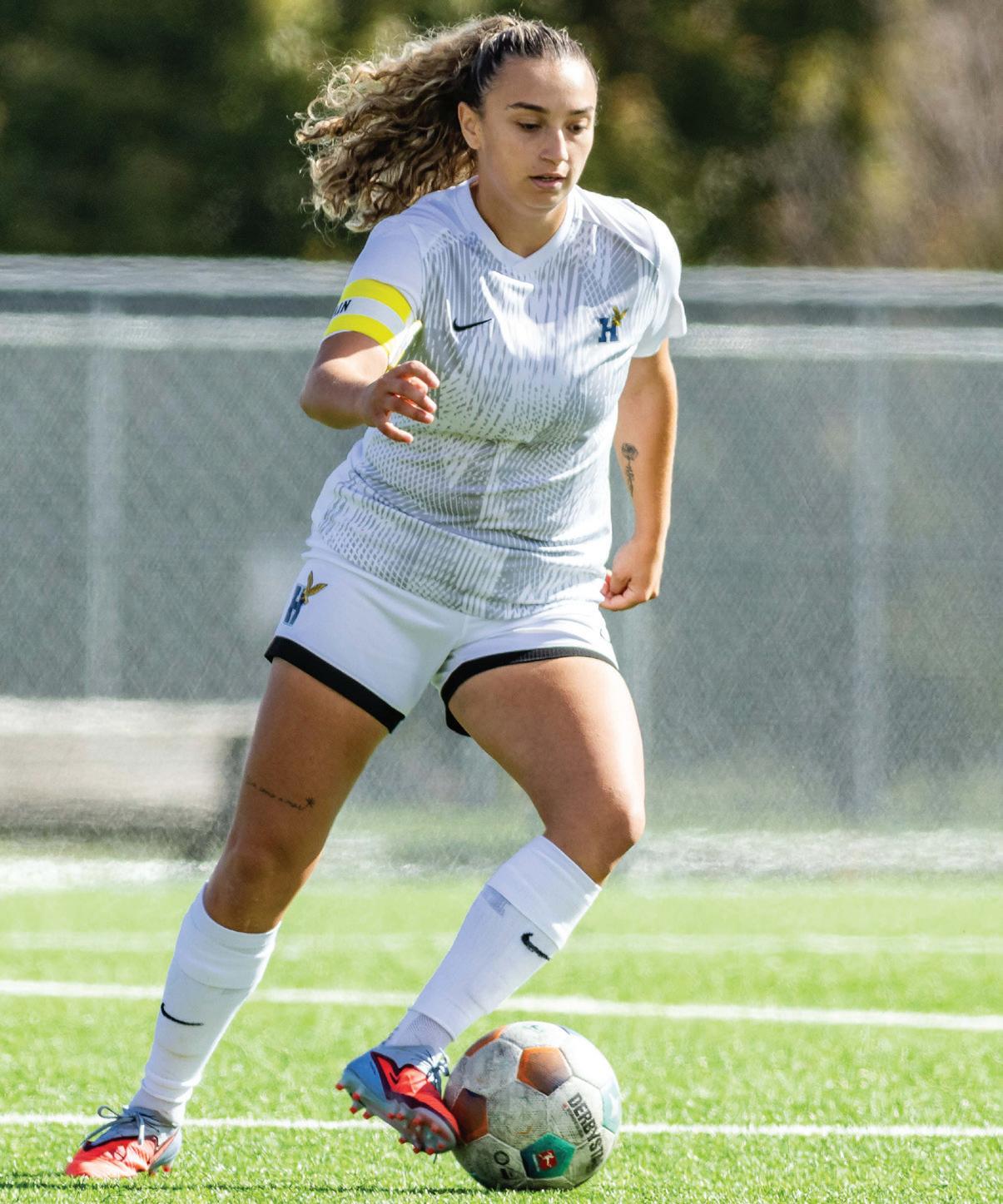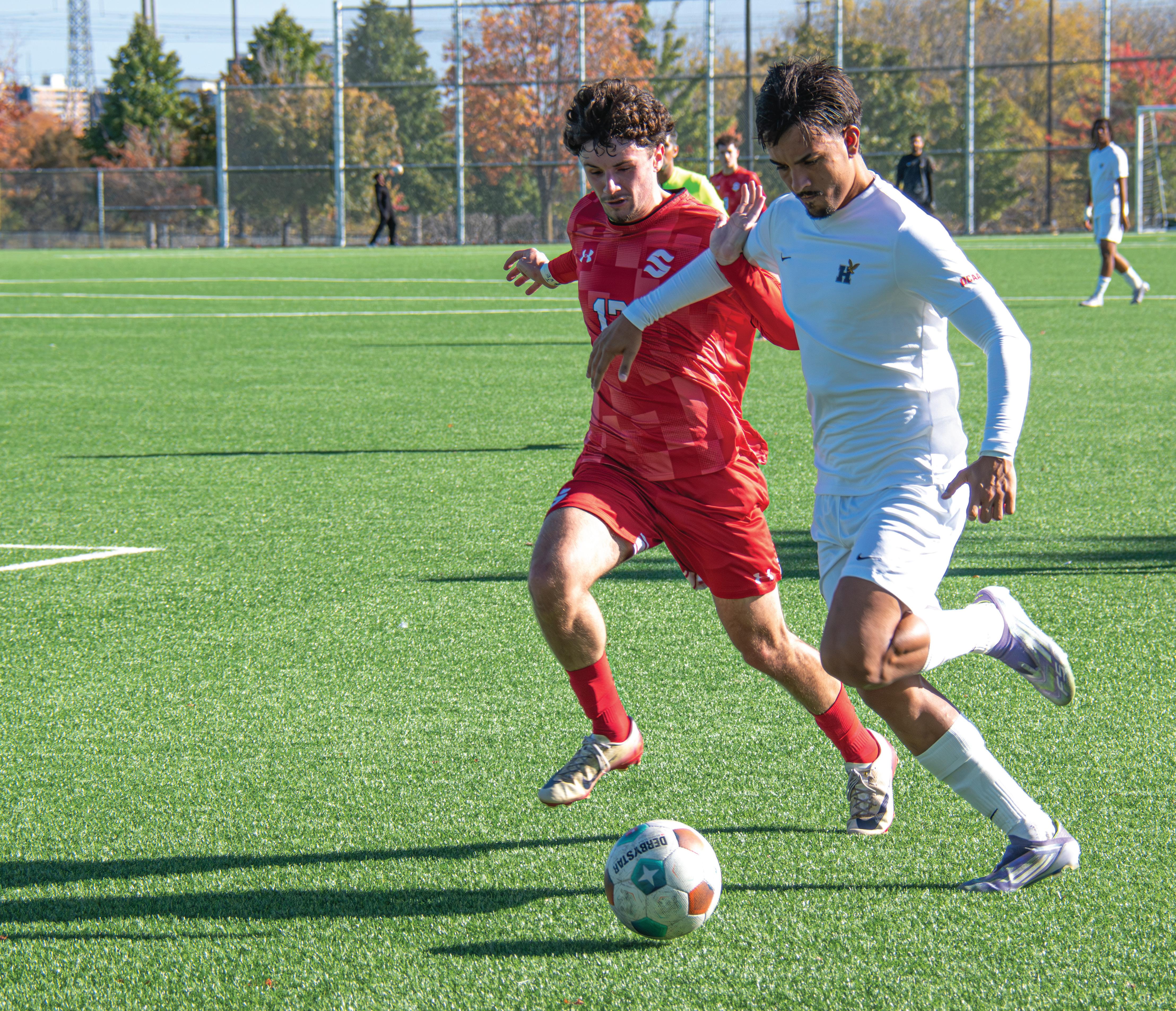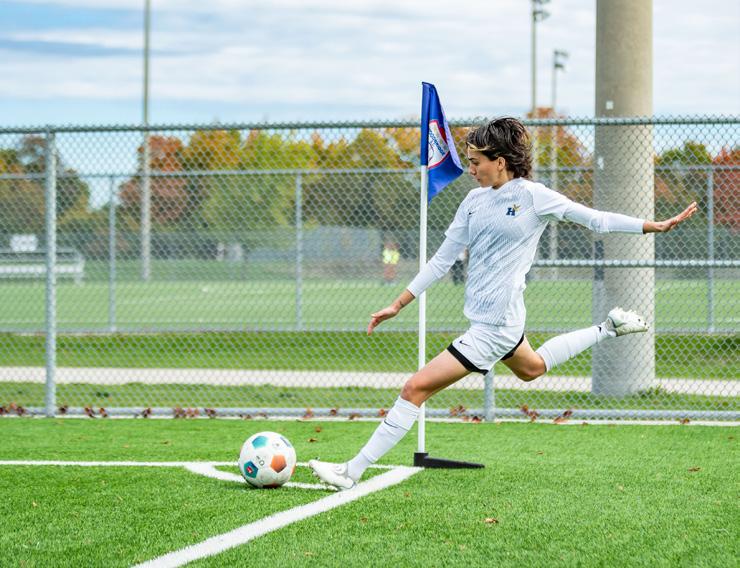HUMBER ET CETERA









Days of negotiations led the colleges and union bargaining teams to announce they reached a deal in the early morning on Oct. 15.
The Ontario Public Service Employees Union (OPSEU) said in a press release that picket lines are coming down and work is scheduled to resume for full-time support staff on Oct. 16 after being on strike since Sept. 11.
The College Employer Council (CEC) said in an announcement released Oct. 10, it invited the OPSEU bargaining team into a private mediation starting on Oct. 11, which concluded this Wednesday, Oct. 15
The weekend-long sessions were with mediator and lawyer William Kaplan, “in an effort to end a four-week-long strike,” according to the CEC.
CEO of CEC Graham Lloyd said in an announcement that it has been a challenging five weeks for those involved.
“We appreciate the persistence of the bargaining teams on both sides, and the guidance of Mediator Kaplan, to reach this agreement,” he said.
OPSEU said the next step for members is to vote on whether to accept this tentative agreement It said that members are still under the last collective agreement until they vote to accept or decline the terms.
The ratification vote is not scheduled but must be completed by Nov. 4, tentative on accepting the agreement, OPSEU said.
The union said in a town hall meeting there would be stronger contracting-out provisions, and
the agreement ensured members would see a two per cent increase to base salary each year. There is also a domestic violence leave provision in the proposed agreement. Recall and severance are enhanced, and it said it has secured language to protect days that don’t get scheduled for Vacation carryover.
OPSEU said the agreement allowed for more benefit increases in vision care, hearing aids and footwear.
The CEC laid out in the Oct. 9 bargaining update that it had offered, among other things, wage increases of two per cent, six per cent vacation pay and two sick days per year and workplace sexual harassment protections.
It stated OPSEU was demanding a six per cent wage increase and a two per cent vacation pay boost, five paid sick days for permanent part-time employees.
The CEC said on Oct. 9 that after four weeks of back and forth, “these demands go beyond what col leges are prepared to accept.”
Chair of the union’s bargaining team, Chris-
tine Kelsey, said in an OPSEU press release that the agreement would not have been made possible without members holding strong these last weeks.
“We had no choice but to fight back amidst a plan to privatize public education, as well as 10,000 job losses and over 650 program cuts across the system,” she said. “The public now understands that our college system is being deliberately defunded as part of the collateral of Ford’s devastating privatization agenda.”
OPSEU said the letter to invite the CEC back to the bargaining table stated that the CEC bargaining agent had spread misinformation about the negotiations and is focusing on “media tours, rather than work towards a resolution.”

“Students, understandably, have been outraged to learn this. Convocations are being cancelled, student access to critical services and support is limited or unavailable, and the semester is slipping away,”
The CEC said the OPSEU bargaining team demanded that any type of “support staff role” can only be per-
formed by support staff,” in an Oct. 6 bargaining update. It said this would mean a dean cannot inform a student about financial aid opportunities or study techniques.
The CEC said in that update that remedies were already available to prevent management from taking over support staff responsibilities.”
Humber’s Faculty of Media, Creative Arts and Design will be hosting coffee meetings, listening sessions and team meetings as support staff return, according to an email message on Wednesday by Senior Dean Guillermo Acosta.
“This is a time for reconnection, healing, and renewal,” he wrote. “We are grateful to have you back, and we are committed to walking this next chapter with you, together.”
Meanwhile, the part-time support staff workers are voting to determine whether they will give a strike mandate to their bargaining committee in negotiations for a new contract. If more than 50 per cent are in favour of a strike, it would give the union the ability to seek a legal strike position, called a no board report, and if necessary, allow them to go on strike.
The CEC said the mediation sessions are scheduled for Dec. 12 and Jan. 28.
OPSEU said that if the strong majority votes yes with the highest participation, it “gives your bargaining team more power at the bargaining table.”
The CEC said on Oct. 14, parttime support staff agreed not to strike for 16 days after the parttime support staff mediation sessions if an agreement is not met.
Samuel Brito Senior Reporter
Humber Polytechnic was recognized with the “Highly Commended” mention at the 2025 International Green Gown Awards.
The Green Gown Awards are given by Sustainability Exchange, which is based in the U.K., putting Humber on the international scale as a global sustainability leader.
The institution received the recognition thanks to its Green Building Standards, a framework that assures new construction and renovations at Humber follow strict sustainability guidelines.
These guidelines exist thanks to the joint work of the Humber’s Sustainability Office and the Capital Development and Facilities Management.
The college applied to the awards early in the year for the Creating Impact category, which rewards institutions for their impact in sustainability using limited or low-cost resources.
Humber’s director of Facilities Management, Spencer Wood, said the recognition is the outcome of all the work done in sustainability for the past 12 years.
“Humber’s been working hard on sustainability for many years,
and energy efficiency specifically.
This award is almost a subset of that,” he said.
Wood said the Green Building Standards are Humber’s approach to its sustainability goals for new infrastructure.
Wood, who is responsible for the maintenance and operation of all Humber Polytechnic’s buildings.
national award that we’ve got.”
He said Humber’s new sustainability project, named Project Switch, intends to reduce natural gas use by the institution by 70 per cent and to achieve zero-net emissions.
“The college has actually committed that we will get there by 2029,” Wood said. “We know what those projects look like. We
“THIS AWARD AND DOING THIS PROJECT, IT’S NOT WHERE WE’RE STOPPING,”
- Sandra Leutri
“There’s a lot of technical stuff in it, but it looks at all aspects of sustainability in a building,” he said.
Currently, the college is constructing a Cultural Hub building at Lakeshore Campus, which is being built using the Green Building Standards, he said.
Wood said the progress and achievements the institutions have achieved are the best way to confirm they are on the right track.
“Other institutions were very interested in what we did,” Wood said. “They’ve been very well received, both in Ontario and in Canada, and now this is an inter-
know what the technology looks like.
“It’s a matter of finding the money and the designs and getting on with it,” he said.
Humber’s Sustainability Manager Sandra Leutri said the Green Building Standards are the future of Humber’s path in its climate change action.
“They’re standards that not only Humber uses for all of our retrofits, new builds, but they’re also publicly accessible,” she said. “It’s all about innovation towards sustainability and innovation for climate action.”
She said these new standards are adaptive and can be recreated
or followed with few resources.
Sandra Leutri is the current Sustainability Manager at Humber and was involved in the application process of the Green Gown Awards. “They’re publicly accessible, so anyone can use them. That’s what makes them so impactful,” Leutri said.
She said Humber has shown how sustainability goals can be reached using the right resources, which makes it one of the influential colleges in Canada in the field.
She said sustainability has three fundamental pillars.
“There’s kind of three strategic pillars with regard to our vision: educate, enable, and engage,” Leutri said.
She said online courses are available for students to gain knowledge in sustainability, called Introduction to Climate Action.
Leutri said more than 1,000 people have taken the free online courses.
She said Humber has a bright future in sustainability.
“This award and doing this project, it’s not where we’re stopping,” she said. “It’s one of the milestones as to us getting to this much bigger goal and becoming an institution where we’re leaders in this sector.”


Greta Rabbetz, 23, from Saskatchewan, is a first-year advertising and graphic design student studying at Humber’s Lakeshore campus.
She left her hometown to travel across the country to pursue more education. The program she is in is a two-year program.
Rabbetz previously studied graphic communications at Saskatchewan Polytechnic and decided to come to Ontario to continue expanding her studies.
Rabbetz said she chose Humber because of the curriculum.
“I wanted to do drawing, editing, copywriting and art direction, and all of those things were offered at Humber,” she said.
When thinking about future career options, Rabbetz said she is focused on using her education for local community issues.
“I’d like to do advertising for things that actually need advertising and that will help people,” she said.
She looks forward to possibly working for the Toronto Public Library.
“It would be great to be a graphic designer for the library,” Rabbetz said.
She said her studies in Saskatchewan have helped her with her courses. She also has experience in photography.
Rabbetz says Toronto is a big change for her, and very different from her home province.
“It’s hard to explain, it’s definitely different. I’m still trying to figure out what that really means,” she said.
Annette Kingsley says her work as a board member for the Children’s Breakfast Club is a personal commitment to her fond memories of coming to Canada as a child.
“I come from an immigrant family, and I know the struggle that my parents had coming from another country, not speaking the language. Both my sisters were born in Italy,” she said.
“I was the only one that had the privilege of being born here in Canada and I appreciate everything that it offered me.’’
Her voice softens as she reflects on those memories. She says she wants to give back to other immigrants who struggle to adjust to a difficult environment.
Kingsley is a member of the board of the Children’s Breakfast Club and joined volunteers Oct. 4 at the Food Terminal to pack boxes of food for distribution to clubs around the GTA.
Volunteers were busy with the Children’s Breakfast Club for Thanksgiving on Oct. 4 at the Ontario Food Terminal, packing boxes of food for families in need.
Rick Gosling, president and founder of the group, said he believes it is his responsibility to help those who struggle and that the Breakfast Club can make a difference.
For more than 30 years, the
group has worked to ensure every family in the community has good nutrition and a hot breakfast.
“Each generation is showing that they care about the communities where they live, that they want to give back. They want to make a difference in their community, and that’s what this is truly all about,’’ Gosling said.
Too often, people get busy with life and forget that people around them need help, he said.
Gosling said the campaign for this year highlights that anyone can have an impact.
“Our focus this year is ‘You can make a difference,’” he said. For 2025, the group’s activities throughout the school year are focused on youth.
Gosling said this isn’t just an event about volunteering. It’s about the connections and friendships volunteers make within the community. Many volunteers return year after year as they can see the positive impact this event brings.
He said he organized the event with Steven Moffat of North American Produce.
“These are all friends of mine,” Gosling said, indicating the terminal bustling with volunteers.
“Hank’s a good friend of mine,” he said, pointing out to helper Hank Idsinga.
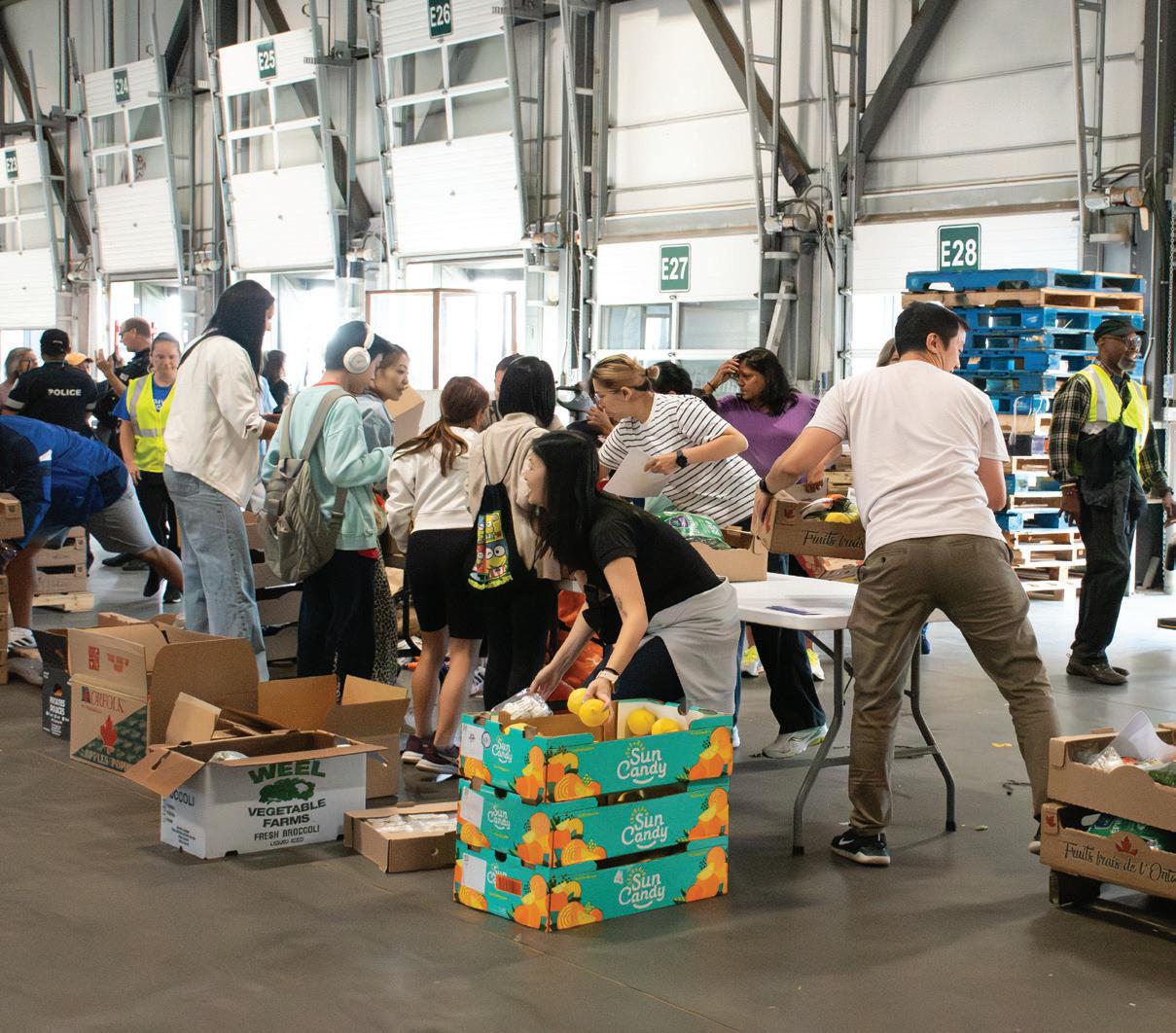
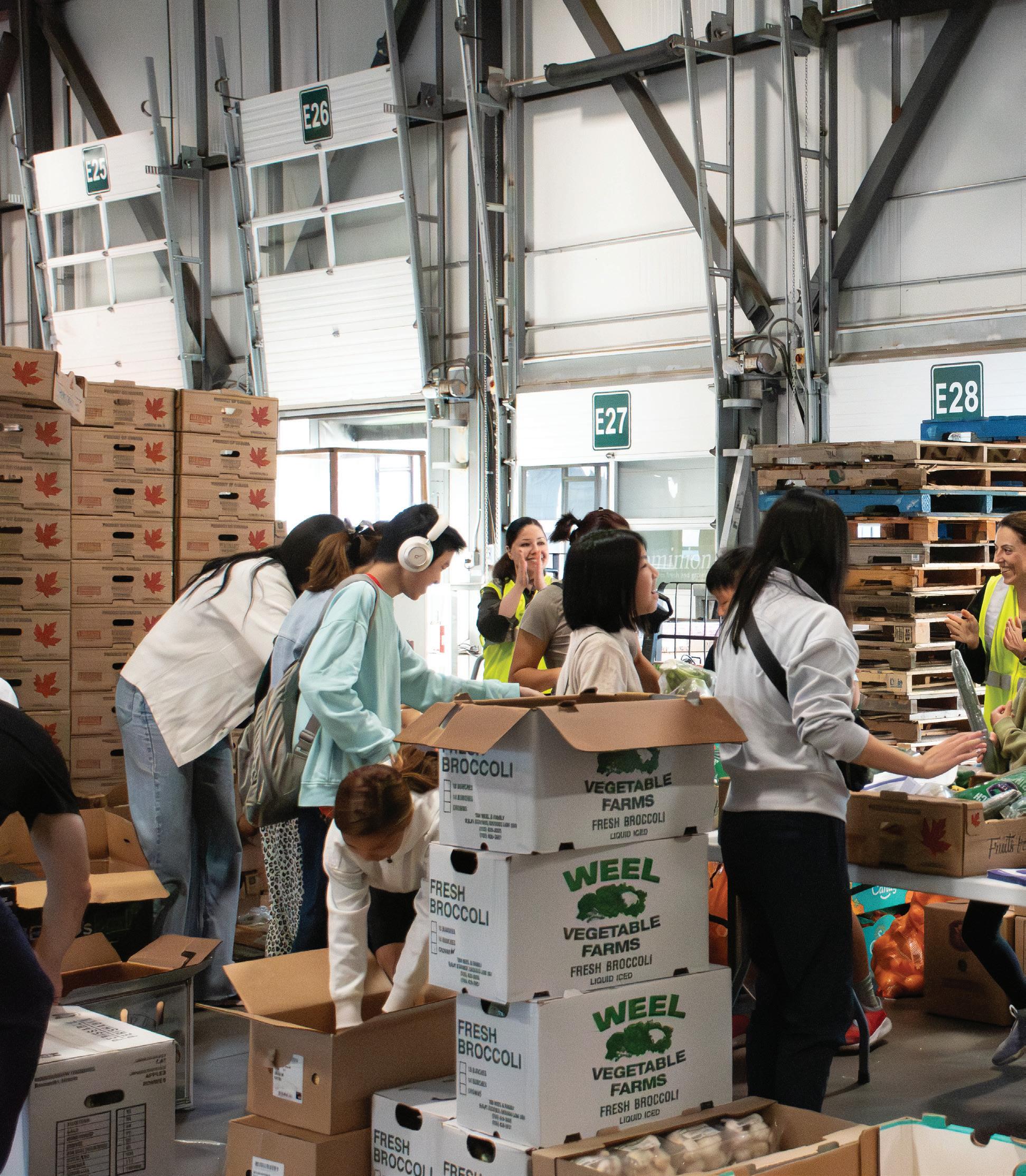
“He sees the benefits of our program. All the people that you see here are here because they see what we do and the impact that our program has on the community and city.”
Moffat said he simply enjoyed seeing the joy on everyone’s faces and the opportunity to give back by doing an act of service.
“You can see the smiles on everybody’s faces, and it’s such a gratifying event to be able to give back to the community,” he said. “It helps people in the community that maybe otherwise wouldn’t have access to this quality and this type of product.”
“To join my team and to join our bunch of services colleagues, the community,
youth, to do what we can to help those that are less privileged in our community, to help them have a great Thanksgiving, to participate in some teamwork, community spirit, and just have some fun, and have some bonding as well’’ is a great thing, he said.
Idsinga, a retired Toronto Police officer and part-time police instructor at Humber Polytechnic, joined his students at the Food Terminal. He shares their motivation.
Idsinga said being involved in this volunteer work is rewarding for the students and helps give them a sense of responsibility as they make an impact and prepare
for their future.
“I love getting the kids in the class involved in this,” the former homicide detective said. “It’s really a big motivator for me as well. They’re just beginning their professional lives, and they can realize all it takes is a couple of hours on a Saturday morning to come out and really make a big impact,’’ he said.
Mark Kingsley, Annette’s husband and a volunteer, said these acts of kindness can put a smile on someone’s face.
“When I’m walking along the street and I see someone basically sitting on the sidewalk and hoping for a
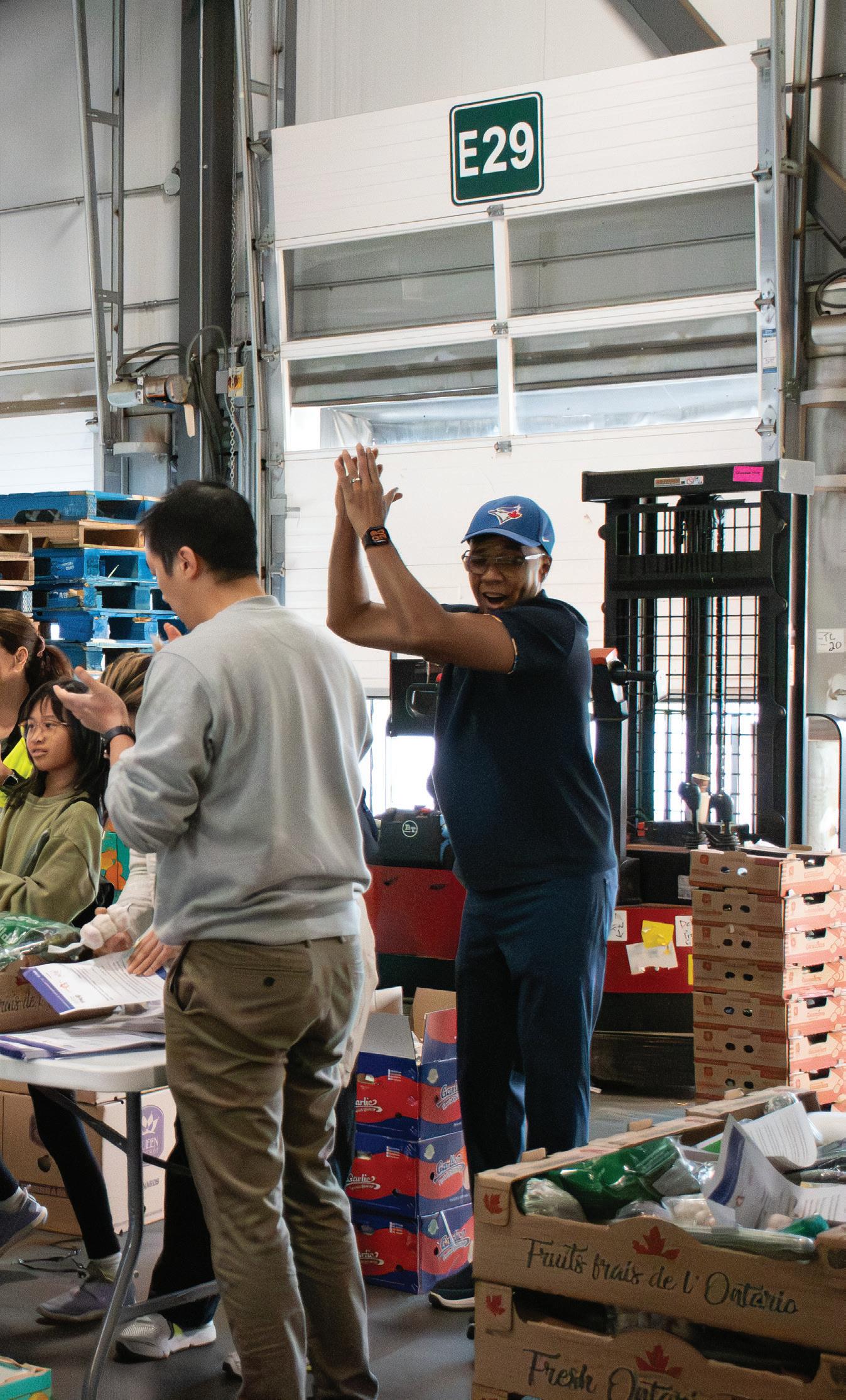
handout, I always, always give them something,’’ Kingsley said. His voice softened with empathy as he explained.
“If I can’t give them something because I don’t have any money on me. Who carries money these days? I will go into a Timmy’s to buy a coffee, bring it out to them. You know, give them something to brighten their day a little bit,” he said.
Lauren Dineen-Duarte, another board member, said she appreciates this opportunity to be part of ensuring all families have food, especially on Thanksgiving.
“Being part of packing all this food for people in need
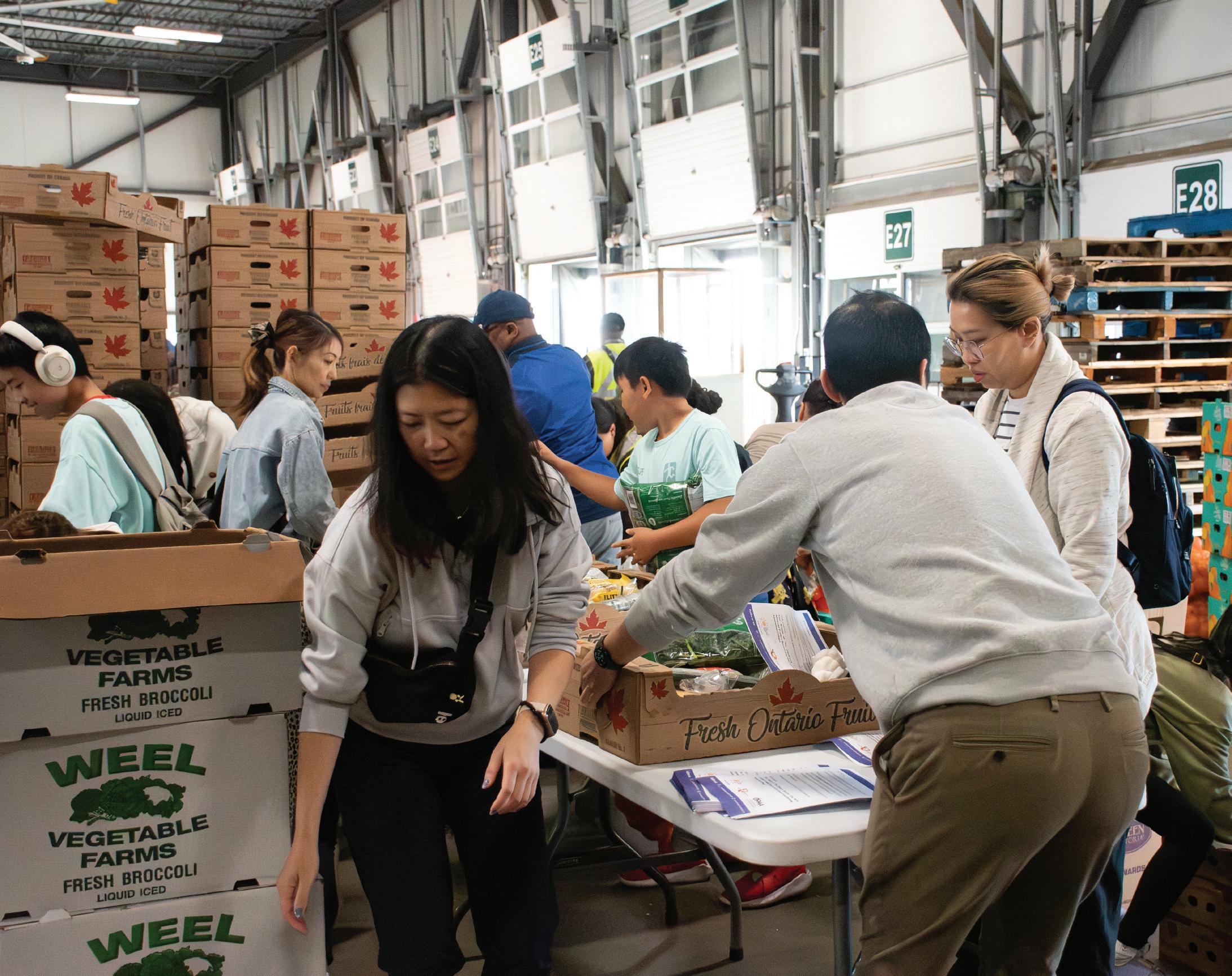
and making sure families have food for the holidays coming up is really a great thing to do,’’ she said.
“Food insecurity is more prevalent than ever, so making sure that, if you’re in a position to give, being able to do that is a wonderful thing to do,”
Dineen-Duarte said.
“We want everybody to be fed and happy and healthy, and so now more than ever, doing something like this ahead of the holidays is really important,” she said.

The Childrens Breakfast Club’s efforts to help the community draws volunteers to help feed the hungry.
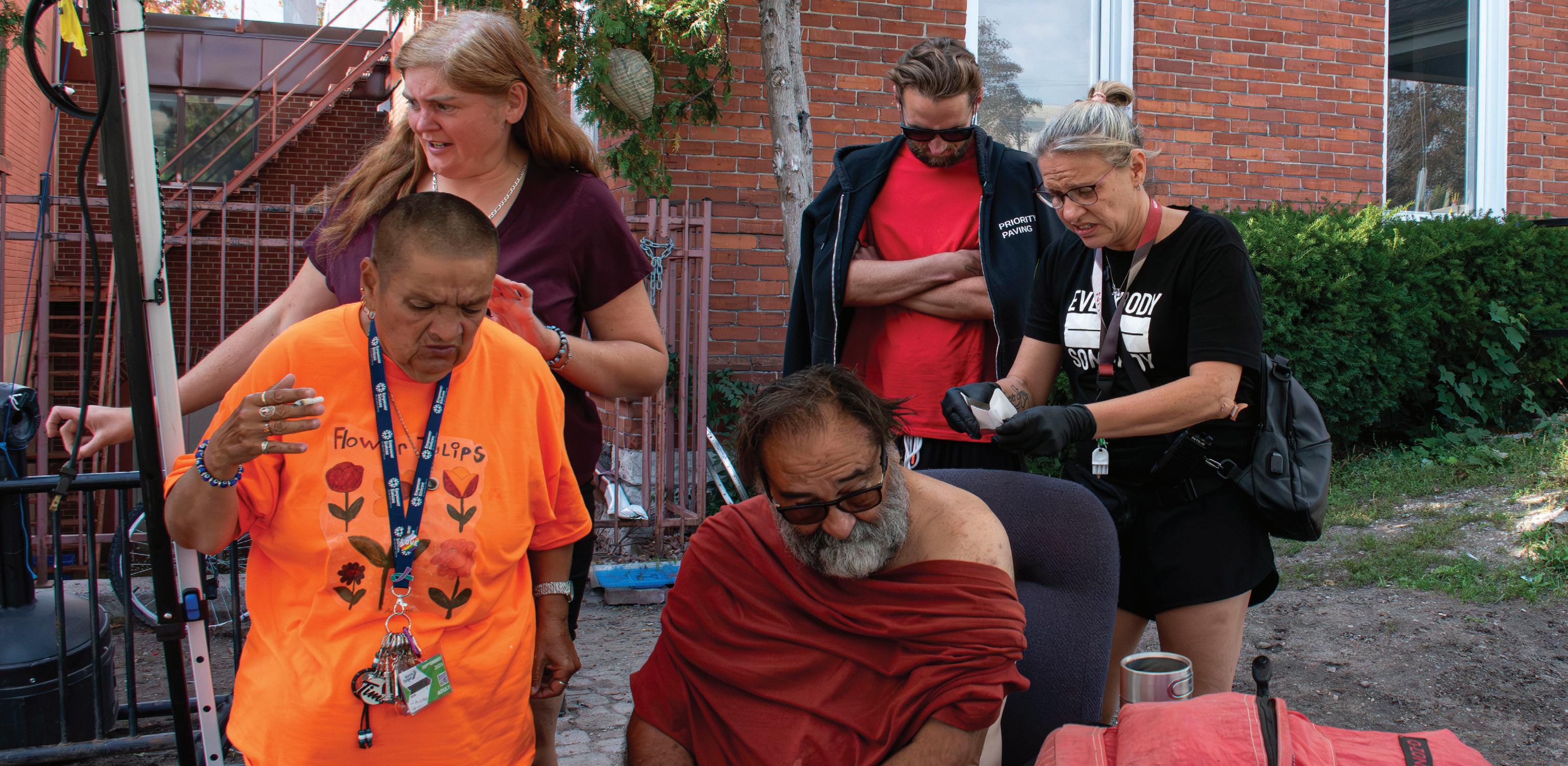
K’Leeanna
Marriott HumberETC News
Living on the streets since she was 17, Rose Lamarche said she is not surprised by the growing number of encampments in her hometown of Barrie.
“It’s not just in Barrie; it’s affordable, safe housing being shut down because of bugs, and people have to pay to live there, but they’re being kicked out if they don’t make enough money in time,” said Lamarche, now 29.
Lamarche said she has experienced periods of stability over the past 12 years, saying that in the unstable times, asking for help has often been met with harsher judgment, which she described as “a bit classist.” She said years of couch-hopping and unstable shelter have left her fearful of what’s to come.
“It’s getting scary, there’s a lot of people I’ve seen pass away as of the last couple of years, whether that’s
Lamarche said.
Her worries reflect the larger emergency at hand. Barrie Mayor Alex Nuttall declared a state of emergency on Sept. 9 to deal with an ongoing encampment issue. It was made a priority after this year’s murders of two men who apparently lived together at the Anne Street homeless encampment.
“This summer in the city of Barrie, in one of our encampments, we had a double homicide with dismemberment of the individuals. Where the police had to shut down the encampment very quickly in order to investigate the situation,” Nuttall said.
Robert Ladouceur, 52, is charged with first- and second-degree murder in the dismemberment deaths of two Barrie men, William “Blake” Robinson and David “Kyle” Cheesequay.
Barrie Today reported police saying, “both men disappeared from a Barrie homeless encampment near Anne and Victoria Street about six months apart earlier this year.”

Nuttall first raised his concerns about encampments in 2018 and 2019, due to the opioid emergency and fentanyl crisis that was spreading across the country.
Nuttall wrote a report about the growing problem, which he said was later dismissed.
“I asked Barrie city council at that point to declare a state of emergency, which they did not do, and so this was something I talked about in the House of Commons when I was a member of parliament,” he said.
“Fast forward to two years later, it got to the point again where I felt that the state of emergency was the correct avenue to be able to meet the day on encampments, and the criminality and lack of safety that takes place inside of them,” said Nuttall, who served as the MP for Barrie-Springwater-Oro-Medonte riding from 2015 to 2019.
However, declaring a state of emergency because of the increase in camps and concerns for citizens’ safety does not address the needs of those living without houses, Lamarche said.
She views the state of emergency as a way of pushing the problem away rather than solving the issues faced by those living without housing. The city is not providing enough food programs, affordable housing, and work.
“Everyone’s staying in the hotels in the state of emergency, but this is happening everywhere. It seems like the officials are trying to push everyone out,” Lamarche said.
While Barrie citizens like Lamarche and her acquaintance Badger talked about being pushed aside, housed resident Brodi Hanlon said the issue with encampments is not new.
“It’s just an issue becoming more visible here,” Hanlon said.
She said she worries the “state of emergency will not address the root of the issues like the lack of affordable housing or mental health and addiction support.”
However, Nuttall said the county of Simcoe is “building 215 units on Rose Street in Barrie that will be for affordable housing and market rents.”
“Barrie has put $30 million on top of that investment and will probably be increasing it to affordable housing throughout our area,” Nuttall said.
He said his plan is “to get individuals to take a long-term look at their lives, to take a long-term look at getting healthy, defeating addictions, or living in a way that they’re
not owning their lives.”
Although housing is important, Nuttall said shelter is a short-term approach to the larger issue, and what municipalities are trying to do is build capacity down the system for individuals who can improve their lifestyle.
Nuttall said, “Work that’s being done right now in the shelters is to coordinate all of these services in a way that allows for success in moving out of a lifestyle on the street and into a more stable atmosphere.”
But for unhoused Barrie residents like Lamarche, the change cannot wait to happen. Help is needed now. Even though homelessness is an “emergency everywhere, it wouldn’t be an emergency if you just dealt with it,” she said.
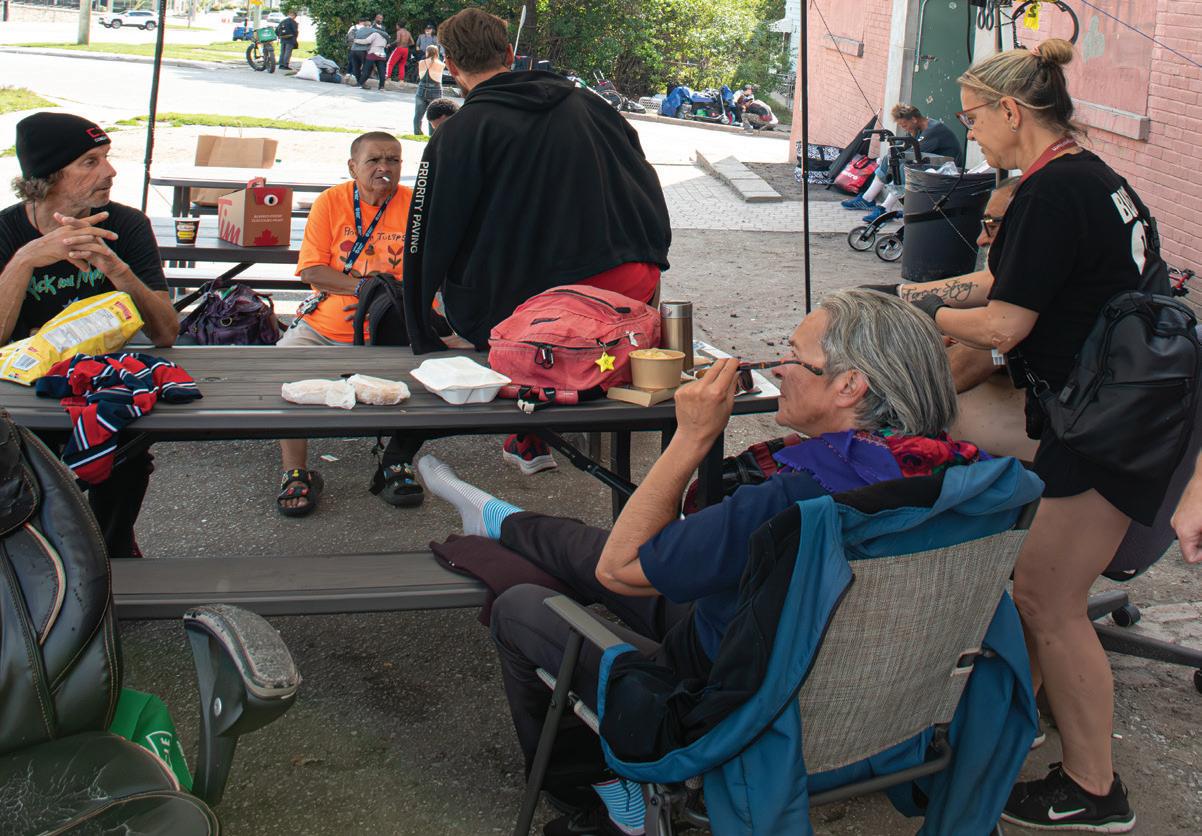
born, to start their spawn’s new life. It’s a breathtaking journey to mark the end of their life cycle.
Each fall, salmon swim through Toronto’s rivers, their powerful migration a reminder that nature is in the concrete city’s backyards. Toronto’s rivers run wild with the annual salmon migration in the fall, as thousands of salmon fight their way upstream to
This annual migration, more commonly called the salmon run, has become a classroom for elementary school students to watch the run, teaching them about Toronto’s wildlife.
”I’ve seen so many school groups come by just to look at the fish,”
and I think that’s so important — teaching them about the circle of life by letting them see it, not just read about it.”
For many, the salmon run represents a rare opportunity to connect with local wildlife in an urban setting. Colin Love, supervisor of community and outreach and education at the Toronto and Region Conservation Authority (TRCA), said the
pass away. It’s a powerful natural cycle that’s happening right in our backyards,” Love said.
Most of the salmon we see in Ontario rivers are Pacific salmon, such as Chinook and Coho salmon, which have been in the area rivers for decades. The native Atlantic salmon, which was once prominent in Lake Ontario, was declared locally extinct in the late 1800s due to pollution and

same streams and rivers where they were born, to lay their eggs and then
Now, local conservationists are working to change that.
“We’re part of a program called Bring Back the Salmon. It’s a province-wide effort to reintroduce Atlantic salmon to their native waters. There are classrooms all over Ontario raising salmon fry and releasing them into local rivers. It’s a great success story,” Love said.
But the excitement of the salmon run also comes with challenges, including people fishing during the migration. Probst noticed that while fishing itself isn’t bad, doing it during spawning season can devastate already vulnerable wildlife.
“Fishing in general isn’t bad, but there’s certain morals and rules you
have to follow, so having people watch over rivers is a really good idea,” Probst said.
Callie Smith, an active nature enthusiast, agreed.
“I don’t think it’s ethical to seek out salmon just for their eggs. You’re actively harming their population. There should be rules stating you can’t fish during these months or at least restrictions on what can be taken,” she said.
The TRCA encourages residents to support conservation efforts in other ways, from reducing pollution and littering to volunteering in clean-up events and restoration projects. Love said the health of Toronto’s rivers is a key part of Toronto itself.
“Having a clean, thriving environment is essential. We’re blessed to have this incredible natural phenomenon happening so close to us. Observing it should inspire us to take care of our rivers, because the health of these salmon tells us a lot about the health of our community,” Love said.
For those who want to see the salmon run firsthand, the TRCA has an interactive map listing recent verified sightings of salmon around the GTA. The run continues throughout the rest of October to early November.
Ethan Alcaidinho Senior Reporter
Humber journalism students filled the halls of Humber last week, handing out the first printed issue of Humber Et Cetera for this school year along with chocolates, pins and a call to read your local campus newspaper.
This launch marks the return of Humber Et Cetera, which connects students, staff and other faculty to the work of the Journalism Advanced Diploma program.
“This is a great opportunity for students to let to community know that they’re out here,” said Lara King, program coordinator for Humber’s Journalism Advanced Diploma program.
“We have a digital platform that people are starting to recognize, but lots of new students and staff don’t know that we actually have a campus newspaper,” King said.
For many journalism students, this event is a chance to see and celebrate their first bylines and see their work in a real printed newspaper.
“I’m pretty excited because this is the first time we’ve actually printed our newspaper this semester,” said
Reet Arora, Humber Et Cetera’s Editor in Chief. “Some of our second years are seeing their stories in the paper for the first time. It’s exciting for them.”
Arora said students have been busy covering major campus events like the recent support staff strike and sports coverage, while experimenting with new tools like drone footage to expand their capabilities.
King said these real-life experiences help prepare students for the fast-paced journalism industry.
“Our students are award winners,” she said. “They’ve been covering the strike that’s happening, working live and different events. It’s a great opportunity to do some on-theground reporting, and this launch showcases all their hard work.”
The launch aims to strengthen Et Cetera’s presence and encourage students to subscribe to their website and newsletter.
“We want to raise awareness and tell people we exist,” Arora said. “People have been signing up, talking to us and even pitching stories, and we want to make sure everyone knows Humber Et Cetera does exist and it’s for them.
King said that Et Cetera plays an
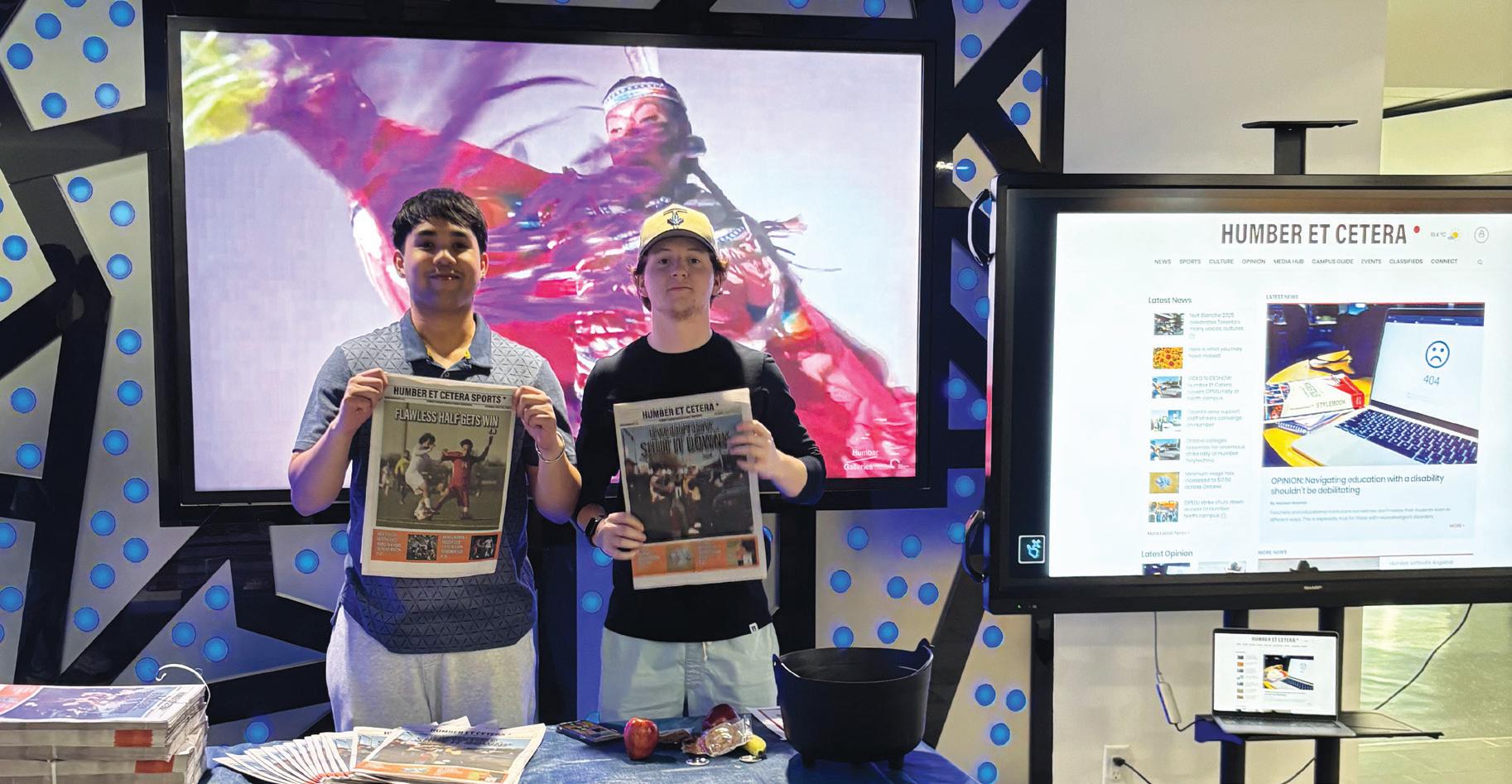
important role in informing the Humber community about events and services they might otherwise not know
“Lots of students don’t get a chance to read everything in their inbox,” she said. “We hope with this newspaper and newsletter, we can get that information out there to them.”
Kristy Jaglal, a University of Guelph-Humber student, said she
would like to see Et Cetera focus more on campus coverage.
“The stories that I would like to see covered by Humber students are definitely more campus events, and I say campus issues,” Jaglal said. “I feel like, because it is called Humber Et Cetera, we should be focusing a lot on the Humber and less on the Et Cetera, if you get what I mean.
“I come here almost every day of
the week,” she said. “I would like to know what’s going on at my school. I totally think student journalism is important.
“I think that we live in a time where everyone thinks they’re a journalist,” Jaglal said.
Humber Et Cetera hopes to keep amplifying student voices and Humber stories with the first print issue going around campus and a growing digital audience.
The start of Mental Illness Awareness Week was on Oct. 5.
In today’s world, posts on awareness days appear to have gained more popularity on social media platforms like Instagram, Twitter, and TikTok, particularly as technology is always evolving. This change works in favour of society.
From Post Traumatic Stress Disorder (PTSD) Awareness Day to World Environment Day, these special days remind us of the real issues happening in the world, which tend to be forgotten.
and fight for better access to care worldwide.
It is also recognized in more than 100 countries and promoted by global organizations such as the World Health Organization (WHO).

One of the greatest things about the tool of social media is that it can be used to our advantage to create awareness. This is especially evident for days like World Mental Health Day, held annually on Oct.10.
World Mental Health Day, which is signified by a green ribbon, was created to remove the stigma about mental health
For instance, on platforms such as Instagram, X (formerly Twitter), TikTok and others, both individuals and institutions have the power to post a message with the snap of a finger.
Hashtags such as #WorldMentalHealthDay or #YouAreNotAlone can increase engagement with the cause and help create a sense of community between users of social media apps. And something as small as a short 60-second reel can create a human connection to the cause.
In terms of support during this month, Humber Polytechnic has offered support within the college and outside of it, too.
It has an ongoing partnership with the Canadian Mental Health Association Toronto (CMHATO), which provides free walk-in and evening mental health support to everyone on campus.
CMHA support is available Monday to Friday from 5 p.m. to 10 p.m. at North and Lakeshore campuses. It allows for timely access to care outside of their regular business hours.
In addition to this partnership, the college has also collabo rated with Togetherall, a service that provides stu dents with free, 24/7 online mental health and wellbeing support. It is com pletely confi
dential and monitored by licensed mental health professionals to ensure safety for all students.
According to a World Mental Health Day Statement by Unifor, Canada's largest private sector union, having a bigger workload is one of, if not the largest, stressors within the workplace.
"Increased demands, without
control, result in physical, psychological and emotional fatigue, and increase stress and strain," the union said. "Emotionally fatigued individuals also have a diminished sense of personal accomplishment and an increased sense of inadequacy."
The union also said this is one of the main reasons employees have negative attitudes about their jobs and/or employers.

And although Mental Health Illness Awareness Week ended, the conversation should continue no matter what. We should continue to use the tool of social media to continuously educate ourselves and others.
Allowing the platform to be used as a space for learning and supporting others' needs when it comes to mental health is important, and the conversation becomes a destigmatized topic of con -

I still remember lacing up skates and strapping on pads at six years old. Sports became world, shaping my childhood in unfor gettable ways. From the beginning, I loved everything about hockey and football. They gave me confidence, structure, and a chance to discover who I was becoming.
Games weren’t just games. They were opportunities to connect, to belong, and experience teamwork in its purest form. It was life-changing.
Locker rooms became a second home. Bus rides to away games, cel ebrations after wins, and even long practices bonded us. These moments shaped lifelong friendships.
Sports weren’t always fun. Coaches screaming, endless drills 'till you puke, and 5 a.m. practices turned joy into stress. The exhaustion became overwhelming.
That’s the hidden reality for many young athletes. The culture celebrates toughness and endurance but rarely acknowledges the toll constant pressure takes on developing kids.
Cheryl Fernandes, a child psychiatrist who works with young athletes, told me burnout is one of the biggest overlooked issues. “We need to talk about it.”
She’s right. Burnout is real. It’s not just physical fatigue — it’s emotional

But there was another side.
keep kids active, teach resilience, and teamwork. But when pressure outweighs joy, the scales tip dangerously against healthy development.
I know because I lived it. Waking up before sunrise, dragging my sore body to practice, I wasn’t motivated. I was scared of letting people down.
Mistakes weren’t teaching opportunities. They were triggers for shouting, punishment laps, or icy stares. At ten years old, failure already felt like the end of the world.
Parents add another layer. Chasing scholarships or pro careers, they forget most kids won’t make
performance alone. Kids need support, not constant judgment.” Looking back, I wouldn’t trade my experiences. But I wonder: how much better would my relationship with sports be if competition wasn’t prioritized above everything else.
What if coaches encouraged fun first? What if mistakes weren’t punished but a part of learning? How many kids would stick with sports longer?
DREAMS TURN INTO EXPECTATIONS, PILING MORE STRESS ON ALREADY OVERWHELMED ATHLETES.
Research supports this. A 2022 Canadian Mental Health Association survey found nearly 40 per cent of student athletes reported significant stress tied directly sports commitments.
That number matters.
Behind every percentage are kids waking up too early, staying up too late, and sacrificing mental health for dreams that often never materialize.
Sports clearly have benefits. They
it. Dreams turn into expectations, piling more stress on already overwhelmed athletes.
The NCAA says less than two per cent of high school athletes play Division I sports. Fewer make professional leagues.
The culture pretends every game is life-or-death. Kids internalize this pressure until fun disappears. That’s how joy becomes burnout.
Fernandes believes reframing goals is essential. “Participation should be about joy and growth, not
reminding people sports are supposed to be fun.
But these approaches aren’t universal. Too many leagues still measure worth in wins and stats. The kids who don’t meet expectations often walk away for good.
So what’s the real goal of youth sports? Is it scholarships and trophies? Or is it building healthy, confident people?

I know teammates who quit, not because they disliked the game, but because the environment broke them. That loss hurts athletes and the sports community.
Sports should encourage openness, but often teach silence. Instead of reaching out for help, kids bottle up struggles, worried they’ll be seen as weak.
Progress is happening. Some leagues now train coaches to focus on mental health. Positive reinforcement is replacing punishment in certain programs. That’s encouraging, but it’s not enough.
Organizations like Kids Help Phone and Canadian Tire’s Jumpstart emphasize inclusion and joy. They’re helping rewrite the culture,
Sports built me up, but wore me down. The lessons were valuable, but the toll was heavy.
The challenge now is keeping the best parts, friendship, confidence, while shedding the damaging culture.
Because no six-year-old lacing up skates or strapping on pads should feel the crushing weight of the world before even stepping onto the field.
Sports should inspire, not suffocate. They should build confidence, not break spirits. And they should bring kids together, not drive them apart with constant pressure.
The next generation deserves better. If we rethink the culture, we can protect the joy of sports. That’s a goal worth chasing.
Matthew Ziniuk, he/him, is a Humber Et Cetera senior reporter. He covers sports and news.


For many, a period of their life is spent in school. As they go through school, they discover themselves, what they like, how they learn, and things that shape them into who they become.
However, some people learn differently than others, which can be caused by neurodivergent disorders like Attention Deficit Hyperactivity disorder (ADHD) or a specific learning disability. Those who are neurodivergent may not know that something made them learn differently from others.
I didn’t get diagnosed with an official learning disability and ADHD until I was 16 in Grade 11. I attended Catholic school until Grade 7, until I was removed due to behaviour issues.
from my previous school.
It was around the end of Grade 7 that I started getting the support I needed. I got an amazing education assistant who worked with me parttime.
Unfortunately, it didn't last long because she left the school. So, until I graduated Grade 8, I would sit in our resource room by myself. I was an inconvenience to everyone. I refused to leave until I had to get on the bus to go home. I was not allowed to go on the annual graduation trip because I was considered a liability, which hurt my self-esteem.
I ended up graduating high school on time, despite everyone’s certainty that I wouldn’t.
Telling children that they are a lost cause is damaging for obvious reasons. Something changed for me in high school, and I became a different person. I made friends with people who I thought would never enjoy my company. My grades weren’t the best, but I tried my best. I wasn’t angry anymore. I graduated on time, with everyone who thought I wouldn’t and left.

I started to attend a new school in a new district, where I tried to get a fresh start, but my background, including poverty, addiction and being underprivileged, and what I knew about life got me removed
I started college in the same year in the fall.
I sent my diagnosis to Humber and received a set of accommodations that properly addressed my needs to make sure I have the same chance as everyone else.
Louie,16, whose last name he didn't want to share because of their age, says his journey started early.
“I received an IEP in Grade 1, and that carried up until I was in Grade 3,” they said. An IEP is an Individual Education Plan for students with different learning needs.
When children learn differently from others, it sometimes shows through in the child's classroom reactions.
“Before I got diagnosed with ADHD, in school, I would get sent away from the groups, to go sit in the corner as a time out, and that really hurt my self-esteem as a child,” they said.
Louie said they struggled with making friends and being around peers at school.
“They excluded me a lot,” they said.
Louie said teachers need to be better at understanding students’ needs.
“I think they need to know how to deal with different types of disabilities because so many of them really don’t,” they said.
Teachers also need to understand the importance of accommodations to a person’s learning journey, and they need to show empathy and consideration.
“If teachers knew how to treat younger kids, my fear of being excluded and cast out wouldn’t be a fear of mine today,” Louie said.
Elayna Medeiros, 21, is a student in media communications. Medeiros has acquired brain injury.
“My journey was a bit of an unconventional process. I first got accommodations because I broke my hands, and I had accommoda-
tions, but in my second year, when I was 19, I got an acquired brain injury.”
When she found out she had a brain injury, she had to explain to Humber that her condition is permanent. Medeiros said she had a great accommoda tions advisor, but Humber replaced the advisors, and now it’s difficult to get any help.
“It's hard to contact them, there's a longer wait list, and they also don’t know anything about me. I lost someone who knew me and my situation, and it's frustrating now that she's gone.
because they maybe don’t know how to do it,” Medeiros said.
Teachers calling out on students is one of the bigger problems with accommodations.

“I’ve had teachers call me out in class, not by naming me, but they’ll give a speech to the class and stand in front of me, and say, ‘You don’t get accommodations in the real world,’ and if you need accommodations, maybe journalism isn’t for you,” Medeiros said.
Post-secondary is different than high school or elementary.
You are paying for an education, paying professors to treat you with respect.
Humber let go of all eight of their accessibility consultants in April 2025, completely vanishing the role and labelling it as “needing to change the way things operate.” But Humber quickly posted jobs for accessibility specialists, reclassifying them as “support staff,” which offered different contracts from the ones they had already. Before April, they were full-time faculty staff. These consultants are and were key in accessibility services like providing advocacy for students with accommodations.
“Professors don’t really understand the accommodation system. They can get annoyed at the system, they take it out on me
“I'm just trying to pass my classes the same way everybody else does. It's not my fault I have a disability,” she said.
Medeiros used a really great example.
“Professors wouldn’t ask anyone with a visible disability why they have accommodations, so why should I have to justify mine?”
Teachers and school boards need to better understand and train their employees to understand that disabilities affect learning, or the ambition that these students have will go unmarked in the system.
Madison Boynton, she/her, is a Humber Et Cetera news reporter. She covers sport, and social justice
Joseph Zago HumberETC Features
AHumber acting professor said he anticipates AI will change the standard in the film industry just as autotuning has done in the music industry.
Actor and Professor Elias Ham said he doesn’t think AI actors are going to replace him in his lifetime, but they could limit opportunities for the next generation of actors. He said the connections he has within the industry make him wanted by casting directors and studio heads, but students may have difficulties as they haven’t yet made those connections.
Ham said a place in the industry is earned by being reliable after working with companies repeatedly, but AI may change all that in the years to come.
“We haven’t felt the full sting of its impact on our society and culture as a whole as substantially and as vehemently as it’s going to happen over the next few years,” Ham said.
AI studio Particle 6 is pushing for the newly produced AI character Tilly Norwood to replace
actors in Hollywood.
Particle 6 launched Xicoia, a talent agency centred around Tilly Norwood at the Zurich Film Festival’s Summit.
Tilly Norwood currently has a portfolio website after its debut in the AI short film “AI Commissioner” at the Zurich Film Festival.
CEO and Founder Eline van der Velden said Particle 6 wants the AI actress to be the next Scarlett Johansson or Natalie Portman in a Broadcast International interview.
Particle 6 has Prime Video, Apple TV Plus and the BBC, among others, as clients. They are developing content using their AI systems.
The acting union, SAG-AFTRA, said in a media statement that it condemns the use of AI actors.
“SAG-AFTRA believes creativity is, and should remain, human-centred. The union is opposed to the replacement of human performers by synthetics,” it said in a statement.
It said Tilly is not an actor but the work of a computer program and built on the performances of actors who haven’t been compen-
sated or credited for their contributions.
Ham said the new AI is not what people are calling it.
“It’s a line of code, it’s a program,” he said. “What it isn’t, is an actor, what it isn’t, is an artist.”
Ham said that people calling it an actor and humanizing it causes people to cultivate a connection to something that isn’t human.
This is not the first time AI has been the topic of discussion in the film industry.
SAG-AFTRA supported the Writers Guild of America in 2023 following the use of AI scripting. As a result, AI is not being utilized to write or rewrite content.
SAG-AFTRA said in the statement that audiences are not interested in watching computer-generated content.
Producers are not allowed to use AI-performing software without complying with contractual obligations, which generally require notice and bargaining, the SAGAFTRA statement said
The Canadian Actors’ Equity Association (CAEA) advocates for live performance actors and per-

formers across Canada. Director of Communications Randy Duniz said in an email statement that the use of AI actors isn’t a concern yet in the live per-

formance industry, although it could have an affect on the livelihood of the members who also do recorded performances.
Executive Director Alex Levine said he has hope that live performances will still resonate with people, and AI, coupled with holograms, will not affect what a human performance can provide to a production.
Levine said few actors earn their full living from acting but it’s getting more difficult in the film industry with AI impeding on smaller roles.
A lot of actors looking to break into the industry are faced with fewer opportunities because studios and people have come to accept AI in commercials or background work.
“We’ve lost that battle,” he said.
Ham said his students are aware and fascinated by Tilly Norwood, but they don’t treat it as an issue that warrants concern.
He said students need to show why they are better for the job than AI, just as they show they’re better than other actors.
Ham said what the people want out of AI will be reflected by studios, and it’s up to the viewing audience to dictate what AI can do within the industry.
He said people should vote with their wallets and voices using social media to connect with the human art that AI does not provide.
“My loyalty is to the art form and to the craft that I’ve dedicated my entire life to,” Ham said.
Laura Rodgers HumberETC Culture
Students learning to take risks, being part of a community and finding new interests were all part of the IGNITE club fair.
“We’ve heard that students have a hard time making friends in university and college. This is a great opportunity to meet some new people with similar interests,” IGNITE student advocate Emily Edwards said about the fair held in the Student Centre on Oct. 1.
The fair showcased a variety of student-led clubs, Edwards said.
She said putting together the event went smoothly. “All of the clubs are prepared and ready and really just excited to talk to students.”
Humber students Keisha Juerra, Rishma Ramlochan and Narisoo Sukhoo said time management is important when joining a club.
Juerra said she should be fine with managing her time as long as she doesn’t overwhelm herself when joining a club.
“Definitely do school stuff at school and home stuff at home,” she said. “You need to manage your time because you will be super stressed if you don’t.”
Ramlochan said clubs could help balance her schedule, giving her dedicated time for both academics and extracurricular activities.
Sukhoo said she hoped the clubs would be flexible regarding students with busy schedules. “I really need
it,” she said.
Host of the Cam’s Kids booth, Alyssa Meuti, said not a lot of commitment is required “in terms of needing to show up for a lot of stuff because ultimately we’re all here to understand sometimes you just can’t make it.”
sounded good, including Cam’s Kids.
“Mental health club. One hundred per cent,” she said.
Edwards said clubs can foster these support systems with students and she thinks “community is
“I’m adopted from China, so I’ve been trying to get involved in stuff that can bring me closer to my culture,” she said.
The Chinese Students Association (CSA) booth was giving out cultural treats. Booth host Chunlun Fan said
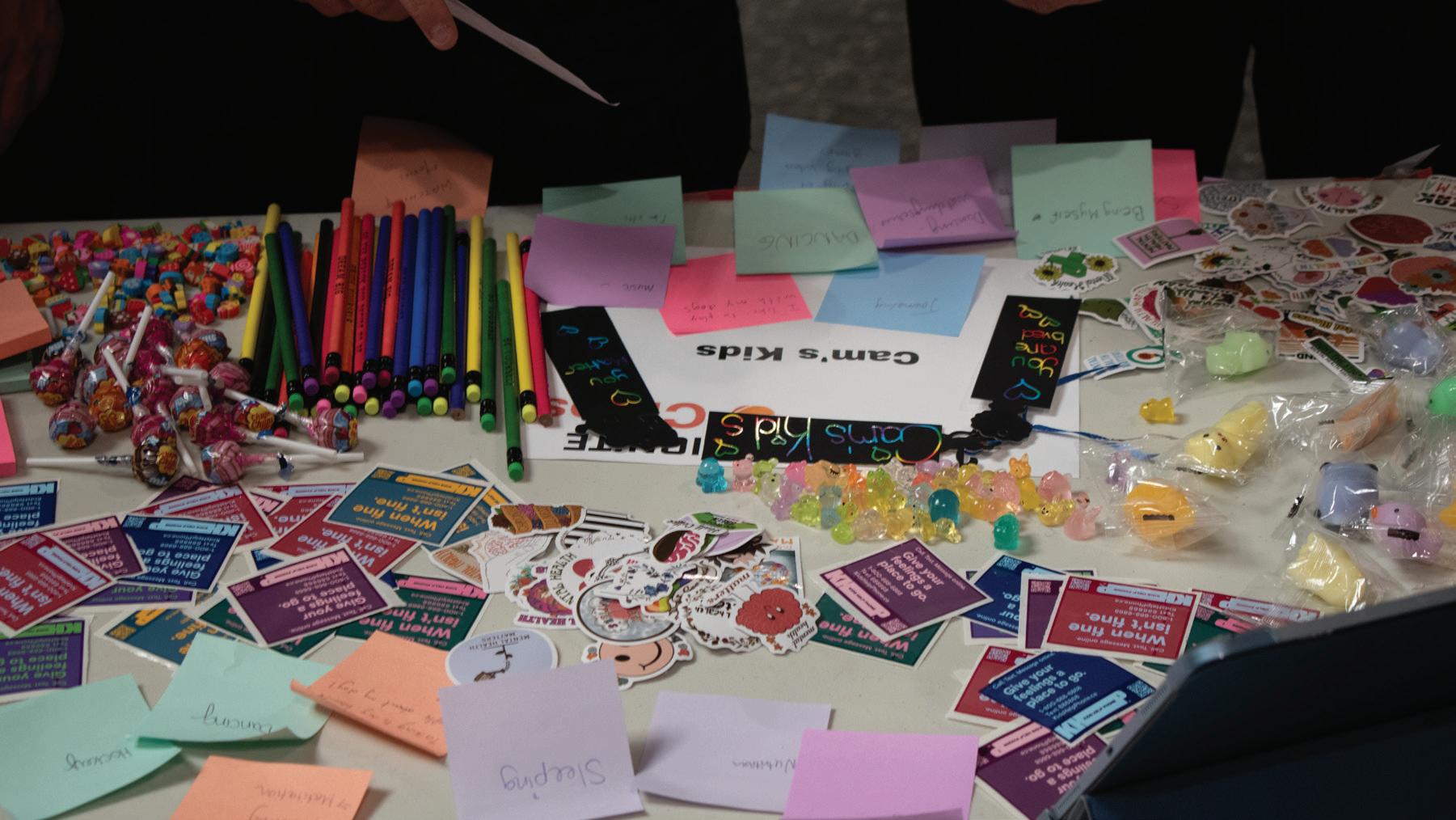
Cam’s Kids Foundation is a movement and an organization dedicated to supporting young people struggling with anxiety.
It said on its website that it does this by creating awareness, providing tools and resources, and encouraging peer-to-peer support. Ramlochan said a few clubs
incredibly important on campus.
“To kind of feel at home on campus,” she said. “Be a part of a club, a community, find people with similar interests and even find new interests for yourself.”
Humber student Vinny Pratt said she attended the Clubs Fair with the Chinese Students Association in mind for that sense of community.
they share snacks every week.
“We managed to share mooncakes for the Chinese students,” he said.
Fan said the CSA is there to support students who speak Mandarin or Cantonese, or for those who want to learn how to speak the languages.
Juerra said her top picks included the Filipino club and the Women’s Student Leadership Association (WSLA).
“I’m really interested in what they (WSLA) are advocating for,” Juerra said.
Fronting the WSLA booth, Hannah Grace Acacio said the WSLA advocates for women on and off campus.
She said it also hosts fun events for the members, “movie nights, self-care days, kind of just a place for women to just come and talk.”
Pratt said she found the Anime Club booth intriguing and Juerra said it interested her the most.
Anime Club president Moses Newman said it was for anyone with an interest in Japanese shows or who wanted to learn about anime.
“It’s just something where a lot of people could just enjoy,” Newman said.
A representative of the Humber North Chess Club, Joss Wood, said if students want to enjoy themselves, experience competitive chess while also having a chill time with likeminded players, “this is your go-to club.”
Anaiya Khan, who represented the Desi Students Association, said that while it was not accepting new members, she encouraged students to attend the events their association was hosting.
Edwards encouraged students who were considering joining a club.
“I would say take the risk,” she said. “There’s a place for everyone.”

My favourite compliment throughout my whole life has always been about my style.
I wore a tiara as a casual accessory and plastic high heels to the grocery store at age five.
As a kid, the only kind of play I liked was dress up, and as I aged, my own closet was where all the fun was. It was a curated version of garments that were a reflection of me.
My runway was my classroom.
But unfortunately for me, there was a dated dress code. No shoulders, and knee-length shorts, so bleh.
I tried to make my sparkly wardrobe work with this dress code. But the bottom-length rule was unrealistic in the summer, and my mom agreed, so I wore what I wanted.
At 11, the weather was getting warmer, and I decided to wear shorts and a tank top to school. The outfit wasn’t unusual for me, a black and white flowy tank top, paired with my favourite high-waisted denim shorts.
The shorts had four exposed silver buttons down the front, and the tank top hit just below the top button. It wasn’t revealing. Not to me, and not compared to what other girls were wearing that day.
The morning had barely begun when my teacher asked me to step into the hallway, and he asked me to put my arms by my side. Confused, I did.
He told me my shorts were too short and that was it. No conversation,
no curiosity, no attempt to ask how I felt. Just a rule.
He called another staff member, who brought me to a supply closet lined with sports jerseys for tournaments. He handed me a men’s XXL basketball jersey and told me to put it on over my outfit for the rest of the day.
The jersey swallowed me, hanging past my knees. It felt like a walking punishment.
I didn’t know it then, but this would be the first of many dress codes. It taught me that teachers had the power to police my body, to just throw on something twice my size to hide whatever they deemed an issue.
In high school, the problem shifted. It wasn’t about shorts anymore. It was about my chest.
It quickly became obvious that the same tops that looked “fine” on my flat-chested friends were suddenly “inappropriate” on me. I wore the same tube tops, the same tank tops,
the same fitted T-shirts, but only I got warnings.
At 15, I was eating lunch in the cafeteria, wearing a tube top, and a teacher tapped my shoulder and asked if I had a shirt to put on over top of my outfit. Fed up, I responded no, not meeting her eye. She asked again, firmer. I said, “Are you going around asking all the girls wearing a tube top this, or is it just me?”
She then sent me to the principal’s office.
What starts as a dress code becomes a mindset: Will this top get me the wrong kind of attention? Are my shorts too short? Should I bring a jacket? These aren’t questions born to understand one’s personal style. They’re critiques of a young woman’s development, of her own body.
Across Canada, dress codes have long been criticized for disproportionately targeting girls.
The dress code whittled me down to not show my identity through clothes,
and this sticks with me now, even as an adult.
Now, I’m 22, and I still think about 11-year-old me in that capacious jersey, and I think about the other times I was dress-coded after that as a teen.
To this day, I hesitate when I get dressed for school. I evaluate the cut of my shirt, the way clothes cling to my body. I never analyze this when dressing for things other than school.
As a college student, I don’t even have a dress code. But it is still ingrained in me what is deemed school-appropriate.
I have always loved fashion and the way it reveals who you are without words, giving me confidence even before I entered kindergarten. So having that expression stolen from the tiara-wearing five-year-old still enrages me.
Aislinn Millette, she/her, is the features editor. She covers culture, fashion and news.
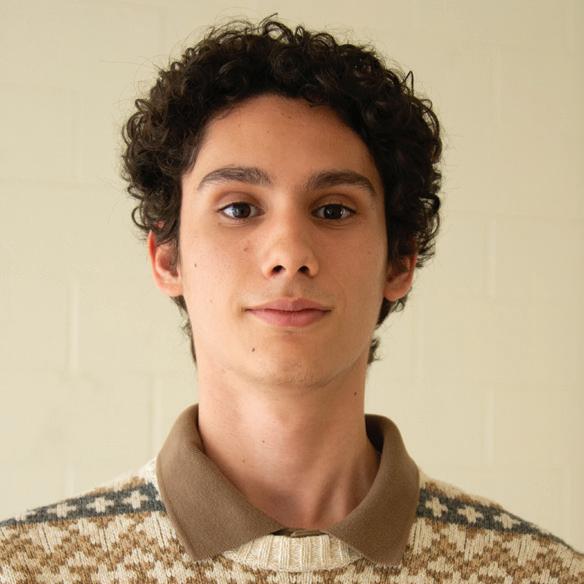
Samuel D. Brito Salas
As the men’s soccer national team reaches its highest FIFA ranking position, situating the team in 26th place, there’s also another angle to view this success.
Canada is having one of its greatest eras with its soccer players on European teams.
Many of them are not only currently a starter for their respective clubs, but also, economically speaking, their value has increased.
Just two weeks ago, on Oct. 4, Canadian players Tajon Buchanan and Tani Oluwaseyi started the game with their team Villarreal against Real Madrid in the mythic Santiago Bernabeu.
Despite the 3-1 loss by El Submarino Amarillo against Real, this
shows a current trend where Canadian players are becoming a key part of their squads in renowned teams. Stats are not the only sign that Canadian players are making themselves a space within the European leagues.
According to Transfer Markt, four of the 10 most valuable Canadian players increased their 2025 market value compared to 2024, with all of them currently playing in European teams.
Twenty-five-year-old Oluwaseyi has already had an impact in his debut season at the maximum European level after being transferred to Villarreal from Minnesota United FC the past summer.
With six games played so far, he’s scored one goal and provided one assist, and has already played UEFA Champions League this season, great numbers considering his adaptation time, his recent move to Europe and the league he’s playing on now.
His current value is €8 million, a rise of €5 million from last December when he was still playing in the MLS.
Oluwaseyi has managed to adapt to the first-level soccer exigence with Villarreal currently placed in third in La Liga, just behind Spanish giants Real Madrid and

Barcelona, respectively.
Another notable example is Belgian side Union Saint-Gilloise centre-forward Promise David, who had a remarkable increase in his market value, going upwards to €13 million from €1.5 million in December 2024.
The 24-year-old Brampton-native has six goals in 17 games played so far this season after a fantastic 2024-2025 season.
He appeared in 39 games, scoring a total of 24 goals and providing four assists with his club,
along with the Belgian Jupiter Pro League title in the 2024-2025 season, and the Belgian Super Cup of 2024.
It is worth noting that the current ranking of the Canadian Men’s National Team doesn’t include injured players, so stars like Alphonso Davies, Alistair Johnston and Moise Bombito would appear in the list as well if they weren’t injured.
This current state hasn’t been decisive in the national team, especially in big tournaments.
The last and best example is Les
Rouges being surprisingly knocked out on a penalty shootout against Guatemala in last summer’s Gold Cup.
Canada’s last friendly games against Australia and Colombia finished with a 1-0 loss and a 0-0 draw, but gave opportunities to new players to shine as well.
Centre-back Luc de Fougerolles displayed a solid performance for Les Rouges against Los Cafeteros, sorting out the pressure from Colombian players in decisive parts of the game and cutting out Colombian counterattacks, especially in the first half.
At just 20, de Fougerolles has seen his market value increase as well while also playing in the Belgian league with Dender, despite the club being the current tailenders.
The next friendly international games are scheduled against Ecuador at home and Venezuela in a neutral location.
And with a squad mostly made up of players younger than 30 years old, there will be more opportunities for new players to demonstrate their qualities in the national team, just as they do with their clubs.

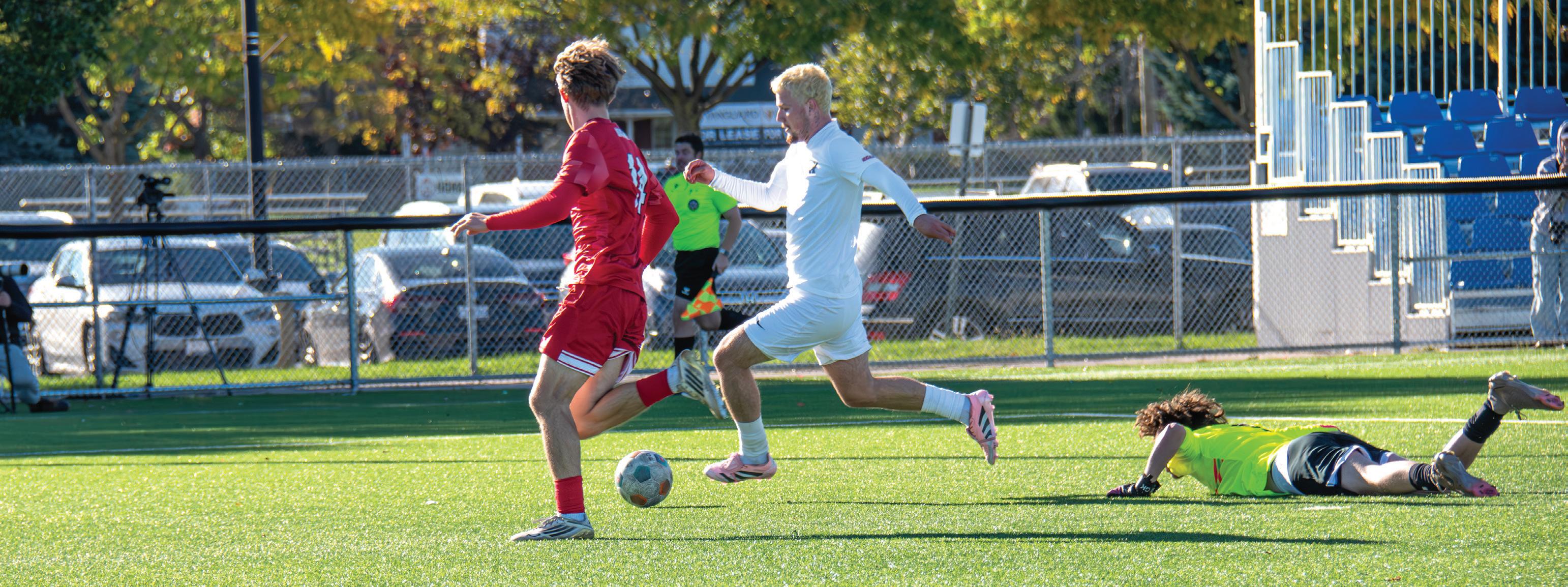
The Hawks’ men’s soccer team is moving on to the Ontario Colleges Athletic Association (OCAA) quarterfinals after defeating the St. Lawrence Surge in the Crossover round on Oct. 15.
The very lopsided 14-0 win marks 11 consecutive wins for Humber, combining the regular season and playoffs.
The Hawks also remain undefeated against St. Lawrence alltime with a record of 3-0, the last match a 3-1 win in 1993.
This is the largest goal margin ever for the Hawks, surpassing their previous record of 13 scored against Mohawk in the playoffs last season, as well as multiple teams in the regular season.
In his first year as head coach, Humber Hall of Famer Jason Mesa has already cemented himself in history.
He is the first coach to finish the regular season with a perfect record in their inaugural season.
This was a feat even fellow 2006 class Hall of Fame coach Germain Sanchez could not achieve.
Mesa said it’s a big accomplishment for him as a coach, but his credit goes towards the players.
“They’ve done a great job in listening to instructions and executing what’s been asked of them,” he said.
The five-time OCAA champion said any players who might be playing their final games for the Hawks will try and achieve as much as they can.
“I know the team is working for them a little bit more. They want to
make sure that they’re finishing off [in] the best possible way,” Mesa said.
The goals were spread out among the entire team, with 10 different players scoring at least one goal.
First-year midfielder Michael Crocco was the clear finisher for the team today, converting all four of his shots into goals.
Third-year midfielder Franz Mella had a combined six goals and assists, the most for the Hawks in the game.
He said his performance helped the team significantly, playing well individually and contributing to many of the chances.
Mella also gave Crocco his flowers after his four-goal performance, saying he’s “proud” of him.
“He got his start after a while
of not playing due to illness, injuries, but he came back and showed us that he deserves a spot in the eleven.”
Crocco set the tempo for the game, scoring a quick brace for the Hawks within the first nine minutes of the game.
Humber would score again in the twenty-third minute when second-year forward Marcus Riviere calmly tapped in a precise pullback pass from Mella to make it three.
St. Lawrence would make some early substitutions to break the Hawks’ momentum, but it seemed not to matter.
The team would find its fourth through fourth-year midfielder Cisco Thomas in the thirty-fifth minute.
The half would end with another goal, scored by Mella, to give the Surge a much-needed break after conceding five in the first half and facing 13 shots.
Starting the second half, it was right back to domination by the Hawks, scoring six goals in just the first nine minutes, which included two from Crocco, one from Mella, and the other three goals from fourth-year players Luca Pinto and Matthew Smith, and rookie Tyler Yasaka.
St. Lawrence decided to substitute goalkeepers after the 11th goal, taking out Luka Obatrov for Rory Patton.
Humber made some subs of their own to rotate the team and give minutes to the less-experienced players, such as second-year
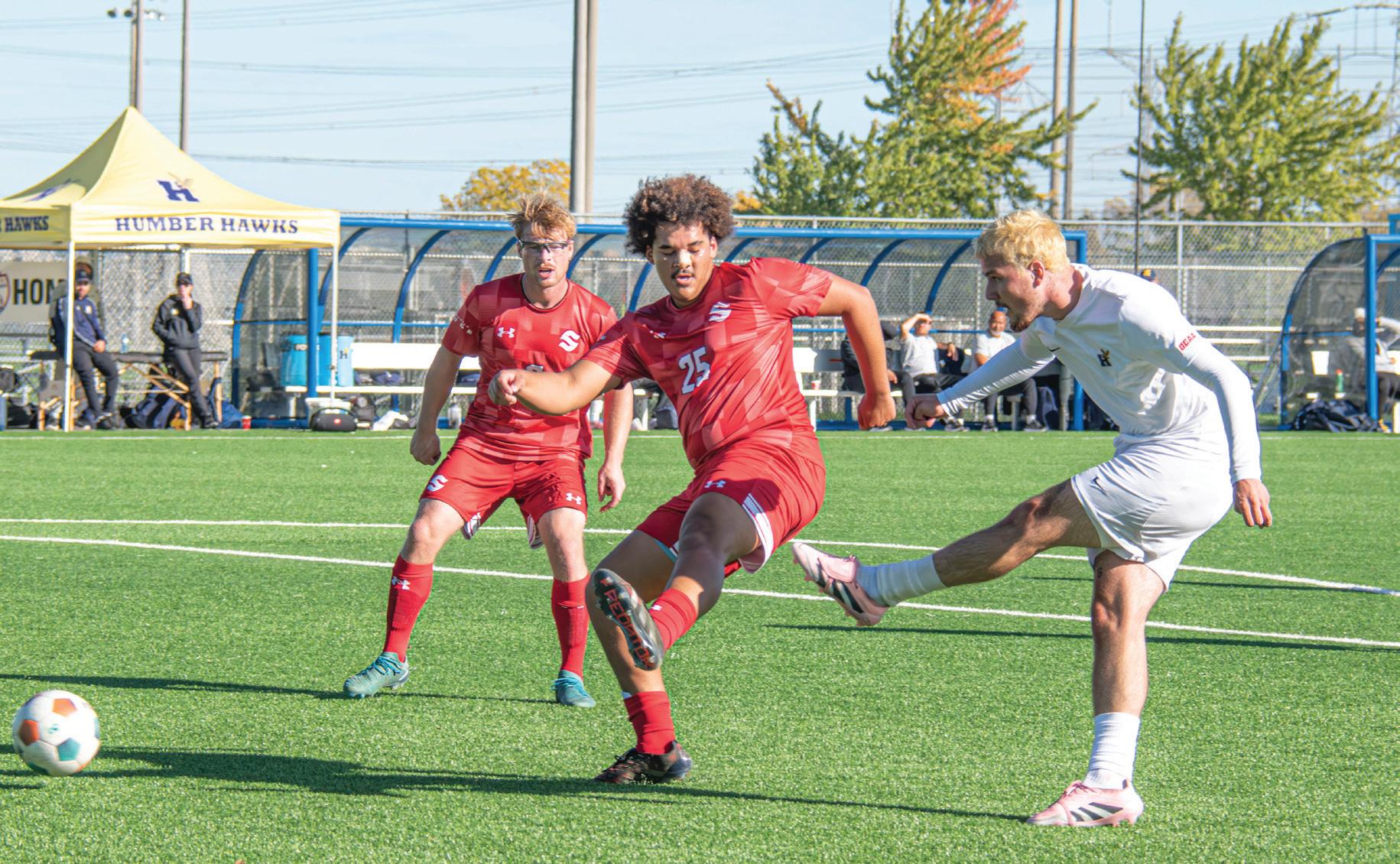
forward Cristiano Candelaresi.
Despite being a bench player, Candelaresi has been the Hawks’ top scorer with five since the 3-0 against Fanshawe on Sept. 10.
Although he scored his sixth of the season, the twelfth of the game, Crocco’s four goals now put him as Humber’s top goalscorer with seven.
Candelaresi said he’s just glad to be playing alongside the other players, whether he’s on the bench or the field.
The Hawks closed out the game, with the final two goals coming from first-year defender Allister Johnson and second-year midfielder Tenzin Wosal.
A one-sided victory for the number one nationally ranked team means they remain undefeated in Crossover matches in the OCAA.
The team will now look towards facing the Niagara Knights, who beat the Durham Lords 2-0.
The players did not know who was going to win when their game finished, but they were confident that no matter who it was, they would be the winners.
“They’re both going to lose, so it doesn’t matter really,” Candelaresi said.
Mella had a similar opinion when asked who would give the bigger challenge: “No one, no one, biggest opponent is ourselves. No one’s giving us trouble this year,” he said.
Humber already beat Niagara this season, when they won 3-0 on Sept. 17.
The match between the Hawks and Knights will take place on Oct. 18 at Esther Shiner Stadium; kickoff is scheduled for 3 p.m.
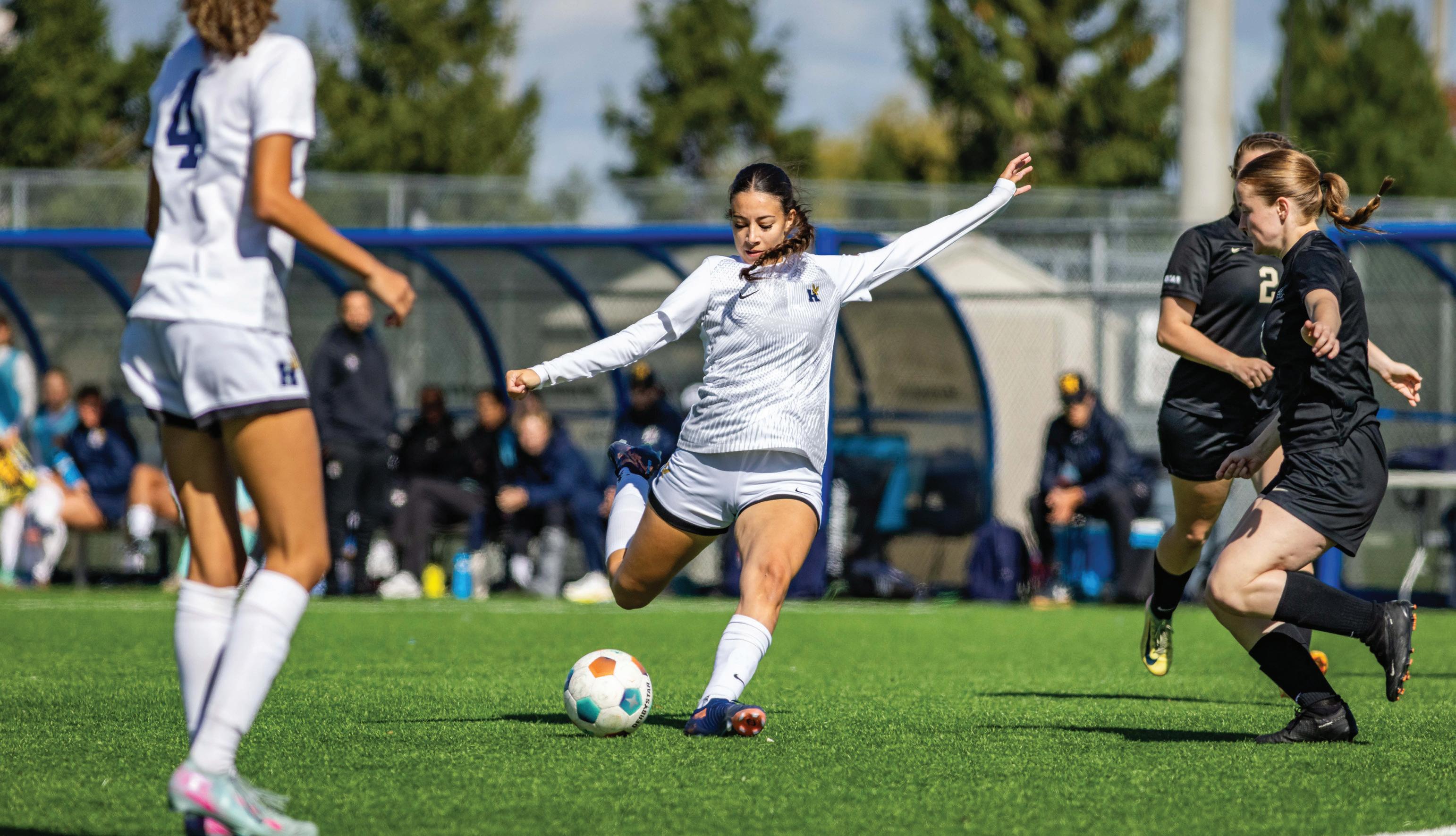
Marco Moretto HumberETC Sports
The Humber Hawks women’s soccer team swooped to an easy 4-0 victory against the Conestoga Condors at the Vaughan Grove Park on Oct. 8. Before kick-off, Humber held its Senior Day celebration for
their graduating players. Fifth-year forward Chantel Spalla and thirdyear goalkeeper Isabella Bernardi were celebrated for their time spent with the team.
Major playoff implications are on the line with Humber sitting in third in the Western Conference at 4-2-2 and Conestoga in fifth in the
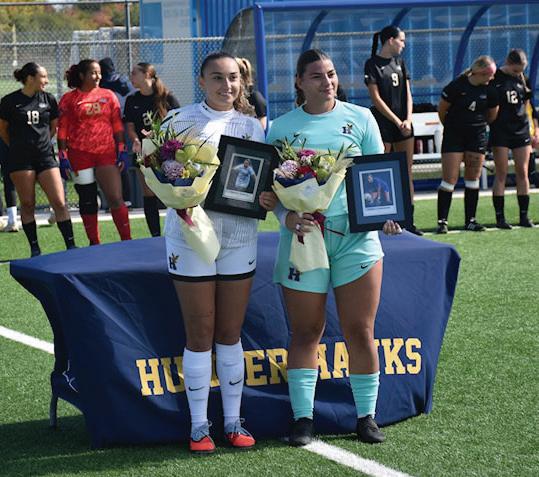
conference at 4-3-1.
“Our training session was focused on making sure that we go back to having effort and intensity in our game. They’re excited to play and get going and get a win,” head coach Jose Caro said.
They lost 1-0 to Redeemer Royals on Oct. 1, which did not affect Humber in the standings, but the Hawks were ready to take on the Condors after a full week of practice and relaxation.
Humber Hawks improved to 5-2-2 and stayed at third in the conference with this win. This was the perfect recovery after the Redeemer loss and a previous 0-0 draw against Conestoga, who is now 4-4-1 and still in fifth in the conference.
“The bounce back from a tie is amazing for sure, considering we won 4-0 from our previous 0-0,” Spalla said. “We shut them down early on in the game, which was huge and continued bringing goals even in the second half. We used what Conestoga did last game to our advantage.”
The coach said the team focused on using the midfield to generate opportunities for Humber’s
attackers.
“We got to make sure we shift our team side to side and try to find those spaces in between our midfielders that can receive and create chances for our strikers and take some shots on net,” Caro said.
After the whistle blew, both sides traded midfield possessions for the first 15 minutes.
In the 17th minute, forward Kaylese Callender intercepted deep in Conestoga’s half. She then dribbled past the goalkeeper, leading to an open tap-in and an early 1-0 lead for the Hawks.
Less than 10 minutes later, Humber doubled its lead with some offensive pressure and a beautiful lead pass from midfielder Elisa Oliveira that split two defenders and found captain Chantel Spalla, who buried it in the bottom right corner.
The Hawks kept up the pressure until halftime.
Humber made it 3-0 two minutes into the second half. Midfielder Mikayla Orrico put some fancy footwork on display down the left wing and put a left-
footed shot to the top left corner, deflecting off Conestoga goalkeeper Skylar Morales.
The Hawks’ pressure and 3-0 lead made Conestoga uncomfortable and it just could not get into any rhythm. After the fourth and final goal in the 75th minute, scored with a precise cross from midfielder Sofia Aguiar to goal scorer Mia Lavorato, the game was all but done.
Before the final whistle, two coaches from the Conestoga bench were given red cards for foul language and complaining towards the referee.
The key to the Hawks’ win was maintaining intensity, calmness and positivity throughout the game. Each player who stepped on the field fought for each other and really earned Humber their win, Spalla said.
With one game left before the playoffs, building off a huge win like this is key to keeping momentum going into the playoffs.
“I think it’s motivating for a lot of our girls and gives them reassurance that for the next game they can get out there and perform and get the three points and go into the playoffs on a high,” Caro said.
Madison Boynton HumberETC Sports
Things started quickly with the women’s Hawks soccer team against Cambrian Golden Shield in the Oct. 15 Ontario Collegiate Athletic Association crossover match.
They scored five goals in the first half, two of them within five minutes, resulting in an emphatic statement by defeating the Shield 6-2 at the Vaughan Grove Sports Park Stadium Field.
Third-year midfielder Micayla Santagudia scored the first goal against the Cambrian Golden Shield’s keeper, Olivia Skinkle, in the eighth minute. Then, rookie winger Olivia Di Cesare, assisted by third-year forward Kaylese Callender, netted the second one in the 12th minute.
against the Golden Shield.
The team was on a high, playing for the chance to make the playoffs. Fifth-year forward Chantel Spalla made it 4-0 for the Hawks.
The cap on this fantastic performance came with 20 seconds left in the first when Callender kicked in the Hawks’ fifth goal.
The Hawks communicated well on the field, producing smooth plays and strong assists.
“We definitely show that in the game, so I want that to continue
and hit double digits with 10 shots so far this season, which makes her one of the top leaders for goalscoring chances.
“It was a 1v1 chance and I just wanted to take that shot,” Oliveira said. “I think today’s game and the score reflect the chemistry.”
The team is feeling good and ready to take on the Algonquin Wolves on Oct. 18 in Ottawa.
“I feel it was a good game to lead the next game, it definitely set the pace for what we’re going to do next, and I think it just gave the team that extra confidence going into the next one,” Oliveira said.
“I THINK TODAY’S GAME AND THE SCORE REFLECT THE [TEAMS] CHEMISTRY.” - Elisa Oliveira
Humber kept the momentum up in the first half and struck again in the 19th minute as Santaguida passed it to Di Cesare to put them up 3-0 with her second of the day
throughout” the playoffs, Callender said.
The second half was quieter for Humber. Fourth-year midfielder Elisa Oliveira scored an unassisted goal, the Hawks’ sixth and final goal, in the 51st minute. Oliveira leads Humber in assists with four
The Hawks’ postseason begins Oct. 18 as they take on the Algonquin Wolves at the Algonquin soccer field in Ottawa in the OCAA Quarterfinal championship.
“I’m excited for what’s to come. It’s a good step up for the next game,” Callender said.
The Hawks are in the sixth spot in the OCAA rankings.
